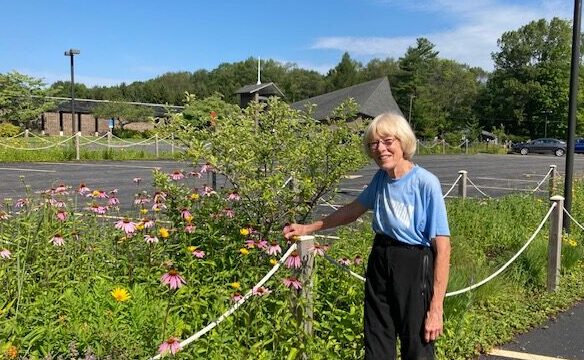By Julia Skaggs, Fund Development Intern, Pitzer College
As many Michiganders know, you can find lawns just about everywhere in our communities. Unfortunately, the typical use of lawn grass doesn’t do much for native flora and fauna. One Montague community member, Claire Schlaff, decided, in 2013, that there was too much lawn and very little plant diversity at her place of worship, White Lake United Methodist Church on Cook Street. By 2022, however, the church grounds include a large rain garden, bioswales, an orchard and pollinator garden. It is a haven full of buzzing bees, leafy ferns, and butterflies flapping their wings. One person’s idea has transformed a lawn into multiple gardens planted almost entirely with native plants and this became possible by using community resources and connecting with others who cared about the environment.
Claire moved to the Montague area in 1971 and worked for Muskegon Public Schools as an Occupational Therapist until her retirement in 2002. Shortly after their move to Montague, Claire and her family become members of White Lake United Methodist Church and have been active members within the church community since then. In addition, Claire works closely with our Lakeshore Coordinator at WMEAC, Tanya Cabala, on environmental issues most pertinent to the White Lake area. Claire is also the primary maintainer of the church garden with the help of other volunteers.
Claire’s journey to transform the landscape of her church was started in 2013 during a White Lake Sustainability Network meeting, when she identified her largest local environmental issue being the lack of plant diversity, or “too much grass.” Through sharing her concern at the meeting, other members connected her to the Great Lakes Stewardship Initiative (GLSI). Subsequently, the GLSI put Claire and her church’s newly formed Green Team into contact with a sixth grade teacher – Jen Szegda – at Montague Middle School, whose students were focused on orchestrating projects relating to rain gardens and grass. The middle school students were able to plant a pollinator garden at the forefront of the church in Spring of 2014.
Upon learning that the church was in need of a new parking lot, the Sustainability Network put the Green Team in touch with a local engineer, who worked with them on an environmentally conscious design. A Green Team member who was a botanist provided useful insight into the final plan. The parking lot was completed in 2015. The Green Team also connected with the Muskegon Conservation District, who helped with the design and planting of the gardens in 2016. Ultimately, the native landscape included two bioswales, a fern garden, a pond/rain garden, an orchard, as well as small trees and shrubs, all of which were rich with native plants.
Through trial and error, Claire continues to work to find the most effective gardening methods. A big piece of advice that Claire has for aspiring gardeners is to be prepared and mindful of invasive species, because they may emerge anywhere.
As environmentalists, we can struggle with seeing value in action on an individual basis, because environmental issues can be so large. In reality, individual action is still of vital significance especially when combined with the resources and connections of the community. As in the case of Claire Schlaff and the White Lake United Methodist Church, we have seen the influence of one individual’s concern blossom into a warm community space of life, vitality and extraordinary peace.


